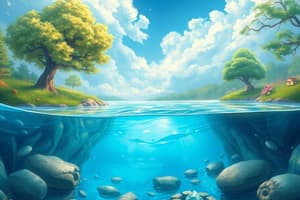Podcast
Questions and Answers
What is the role of hydrogen bonds in water's unique qualities?
What is the role of hydrogen bonds in water's unique qualities?
- They lead to water's low latent heat.
- They decrease water's ability to dissolve substances.
- They cause water to have a high specific heat capacity. (correct)
- They prevent water from evaporating at all.
Which factor most significantly affects the movement of groundwater?
Which factor most significantly affects the movement of groundwater?
- The amount of rainfall in the area.
- The topography of the land.
- Surface water bodies' evaporation rates.
- Soil texture and porosity. (correct)
What is a characteristic feature of a watershed or drainage basin?
What is a characteristic feature of a watershed or drainage basin?
- It is always a flat area with no hills.
- It only includes surface water bodies.
- It cannot be affected by human activities.
- It collects water from surrounding high land. (correct)
How does land use impact freshwater ecosystems?
How does land use impact freshwater ecosystems?
What distinguishes point source pollution from nonpoint source pollution?
What distinguishes point source pollution from nonpoint source pollution?
What is the term for the water held underground in aquifers?
What is the term for the water held underground in aquifers?
Which process describes the movement of water vapor into the atmosphere from plants?
Which process describes the movement of water vapor into the atmosphere from plants?
What is the measure of the void spaces in a material that can be filled with fluids called?
What is the measure of the void spaces in a material that can be filled with fluids called?
Which of the following best describes a 'drainage basin'?
Which of the following best describes a 'drainage basin'?
What is the main characteristic of 'meanders' in a river system?
What is the main characteristic of 'meanders' in a river system?
How is 'water quality index' (WQI) typically assessed?
How is 'water quality index' (WQI) typically assessed?
What happens during the process of 'infiltration'?
What happens during the process of 'infiltration'?
Which component is NOT directly involved in the water cycle?
Which component is NOT directly involved in the water cycle?
Flashcards are hidden until you start studying
Study Notes
Water Cycle
- The water cycle describes the continuous movement of water on, above, and below the surface of the Earth.
- Water cycle reservoirs include oceans, glaciers, ice caps, groundwater, lakes, rivers, soil moisture, and the atmosphere.
- Water cycle transport modes include:
- Advection: movement of water horizontally in the atmosphere
- Uptake: absorption of water by plants
- Transpiration: release of water vapor from plants
- Infiltration: downward movement of water into the soil
- Sublimation: direct transformation of ice to vapor
- Deposition/Desublimation: direct transformation of vapor to ice
- Evapotranspiration: combined loss of water from evaporation and transpiration
Unique Properties of Water
- Water is a polar molecule with distinct positive and negative poles.
- Hydrogen bonds form between water molecules due to their polarity, giving water high cohesion, adhesion, and surface tension.
- High specific heat capacity of water means it requires significant energy to change its temperature.
- Water has high latent heat values, meaning it absorbs or releases a lot of energy during phase changes.
- Water can exist in all three states of matter (solid, liquid, gas) at temperatures found on Earth.
Groundwater
- Groundwater is freshwater found beneath the Earth's surface.
- Groundwater is stored in aquifers: underground layers of rock or sediment that hold groundwater.
- The water table marks the boundary between the saturated zone where pores are filled with water and the unsaturated zone where pores are partially filled with air.
- Permeability: the ability of a rock or sediment to transmit water.
- Porosity: the percentage of void space in a rock or sediment which can hold water.
- Recharge: the process of replenishing groundwater through infiltration.
- Aquitards/Aquicludes: layers of rock or sediment that restrict the flow of groundwater.
- Soil texture variability impacts water and pollution infiltration:
- Clay has small pores and low permeability, restricting water flow and promoting pollution infiltration.
- Sand has large pores and high permeability, allowing water flow and reducing pollution infiltration.
- Silt has intermediate pore size and permeability.
Surface Water
- Surface water is freshwater found on the Earth's surface, including rivers, lakes, streams, and wetlands.
- A river system is a network of interconnected rivers and streams that drain a specific area.
- A watershed or drainage basin is an area of land where all water drains to a common outlet.
- A watershed divide separates adjacent watersheds.
- Factors that impact river transport of water and sediment:
- Stream gradient (slope): steeper gradient, faster flow
- Stream channel width and depth: wider and deeper, faster flow
- Discharge (volume of water flow): higher discharge, faster flow
- Load (amount of sediment): higher load, more erosion and deposition
Water as a Resource
- Water budget: a calculation of the balance between water inputs (precipitation, recharge) and outputs (evaporation, transpiration, runoff, usage).
- Point-source pollution: pollution from a single, identifiable source (e.g., factory discharge)
- Nonpoint-source pollution: pollution from multiple sources over a large area (e.g., agricultural runoff)
- Human activities, particularly land use changes, alter water flow and quality:
- Urbanization: increased runoff, reduced infiltration, higher pollutants
- Agriculture: fertilizers, pesticides, and animal waste pollution
- Deforestation: soil erosion, increased runoff, altered flow patterns
- Climate change: altered precipitation patterns, increased drought, and flooding.
Stages of a Stream
- Youthful: V-shaped valley, steep gradient, fast velocity, high erosion, and low discharge.
- Mature: wider valley, gentler gradient, slower velocity, less erosion, higher discharge, and the formation of meanders.
- Old Age: very wide valley, very gentle gradient, very slow velocity, low erosion, very high discharge, and the formation of oxbow lakes, point bars, cut banks, deltas, and natural levees.
Studying That Suits You
Use AI to generate personalized quizzes and flashcards to suit your learning preferences.




